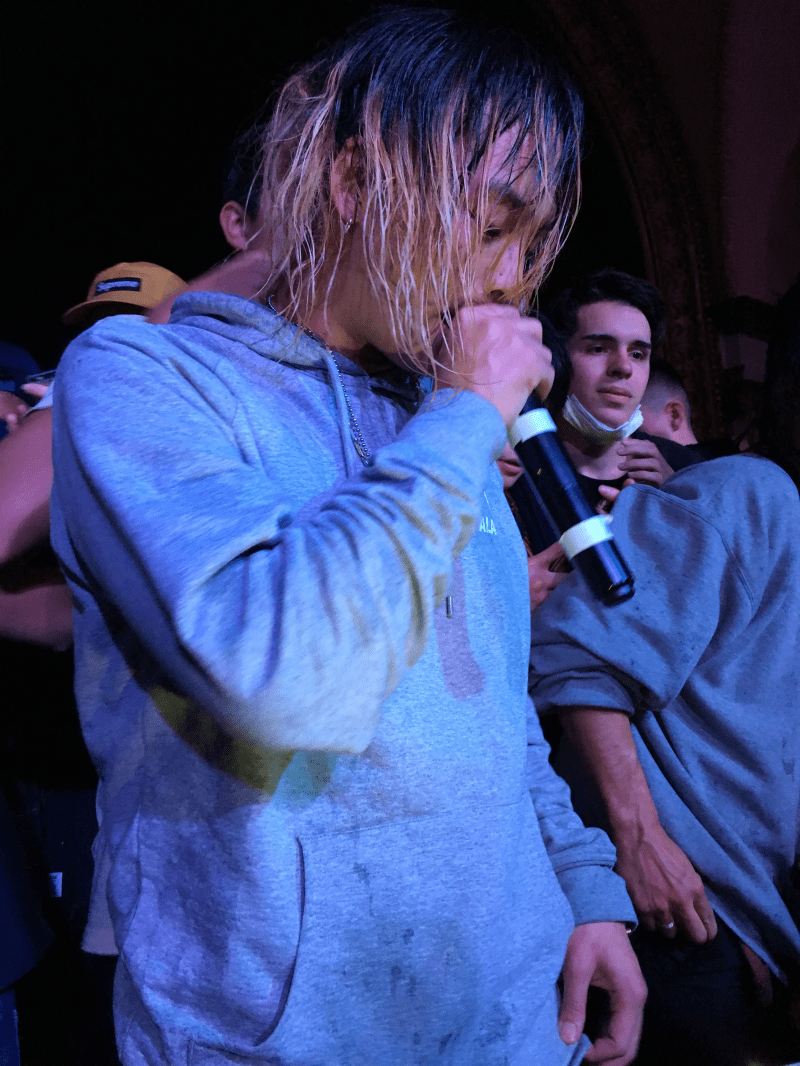
Closing out an explosive year, the Korean rapper Keith Ape continued his first American tour with a gig at Venue, a small nightclub in downtown Oakland. The show was intimate, rowdy and reckless, ending abruptly after a dancing mob formed on stage and tripped the sound system. But disregarding the night’s performance, the event’s popularity struck me as remarkable. Who were the fans flocking to see a non-English speaking rapper from Seoul?
One year ago, Keith Ape was anonymous. He was unknown even in local terms, disappearing in the shadow of polished K-pop supergroups and megastars like Psy, 2NE1 and Big Bang. Stuck in the underground of a faltering rap game (“Korean rap, it sucks. Bad,” says Ape in an interview with Complex), Ape was limited by the isolating forces of culture, geography and industry.
So he looked outward — to Atlanta, specifically — and cribbed the sound and style of OG Maco’s music video “U Guessed It.” The result was “It G Ma,” a project featuring Korean and Japanese rappers JayAllDay, Loota, Okasian and Kohh. Both videos feature sucker punch flows, minimalist trap beats and lo-fi visuals, and despite accusations of plagiarism from both critics and Maco himself, Ape’s interpretation of Atlanta trap has launched him to cross-cultural stardom.
Ape’s popularity comes almost entirely from America, where his music finds its roots. Ape first picked up hype on platforms like WorldStarHipHop and Pigeons & Planes, where, in the tradition of Louis Vuitton and Rolex, he was advertised as a Korean knockoff of the real, American deal.
“It G Ma” only contains a handful of English phrases, but they are designed to grab your attention and not let go (“Underwater squad! Orca ninjas go rambo!”). The song’s title itself is a rough Anglicization of the Korean phrase ij-jima, “never forget,” chopped into simple syllables for the sake of the non-Korean ear.
Language aside, American listeners loved the song’s catchy, nonsensical hooks and aggressive trap sound, and many posted enthusiastic reactions on Vine and YouTube. With a little love from Korean-American hip-hop tastemakers like Dumbfoundead, Jaeki Cho and Donnie Kwak, Ape was able to turn his viral fame into a U.S. tour — his first trip to the States — and begin working with the likes of rappers A$AP Ferg and Wacka Flocka Flame.
When I saw Ape perform in Oakland in December, nearly a year since the release of “It G Ma,” this momentum was still going strong. As I walked down the block outside the club, waiting for doors to open, I took a moment to examine the diverse and sizable crowd queued up alongside me to see Keith Ape, Korean trap star. I noticed that more than a few fans were rocking surgical masks, a nod to Ape’s favorite accessory.
Like many Korean youth, Ape doesn’t wear the mask for health reasons — it’s a fashion statement. In much of East Asia, in fact, prophylactic masks are used in streetwear as often as they’re used to avoid the actual threat of disease. In America, however, the mask remains a symbol of Ape’s foreignness.
The mask and its associations quickly remind me that Ape is the only Asian among the year’s noteworthy hip-hop successes, and the only in recent memory, too. I’m reminded that Asians and Asian-Americans struggle to remain even on the fringes of the American hip-hop consciousness. I’m reminded that despite moderate successes like MC Jin, Far East Movement and Chad Hugo, Asian artists are still footnotes in rap history.
I’m reminded, too, that Asian marginalization in hip-hop can’t be explained away by the usual factors that conspire against struggling rappers. If it were a lack of talent, we wouldn’t have MC Jin or Dumbfoundead, two artists who have made their names as dominant battle rappers. And if it were solely because Asians are outsiders in hip-hop’s black culture, wouldn’t Iggy Azalea and Macklemore be watching the Grammys from home?
The mask evokes all of these thoughts and more. When I see Ape’s fans copping the look, I wonder if their appreciation is genuine or if they’re just reveling in the oddity of an Asian rapper. This skepticism extends to myself, too, and I wonder why I’ve been following Ape so intently when I straight up laughed the first time I saw “It G Ma.”
I wonder: Will Asian rap ever shake its novelty and be accepted as normal?
It’s impossible to say. The path to cultural acceptance is unpredictable and fraught with exceptions, caveats and contradictions. For those marginalized, the shortcuts offered by cultural appropriation and the exploitation of stereotypes often prove either too easy to compromise or too difficult to avoid in systems not built for Asian participation. There’s no telling when or if an Asian rapper will be seen as just a rapper, an Asian actress as just an actress, an Asian athlete as just an athlete.
Ape’s success is a step in that direction, albeit a flawed one. His achievements are built on borrowed culture (or stolen, depending on who you ask), and it’s easy to write him off on that offense alone. There is something fraudulent that hangs about him, and it is reason to give pause. But it doesn’t negate his virtues.
Keith Ape is many things, good and bad. He is an artist, an appropriator, an eccentric, a Korean. And perhaps most notably, he is a disruptor. He presents himself honestly, emphatically, and we are left to deal with the fallout. He challenges the genre, for better and for worse.
Even considering the many complications brought to the fore by a Korean trap star, there is some consistency to it all. Wherever he goes, Ape carries signs of change to come.
I know this because at a Keith Ape show, wearing a surgical mask is cool. Drinking makgeolli and speaking Korean is cool. Being Asian is cool.
This is change I can get behind, and Keith Ape is leading the way.
It g ma. Never forget.
Contact Benjamin Sorensen at bcsoren ‘at’ stanford.edu.
